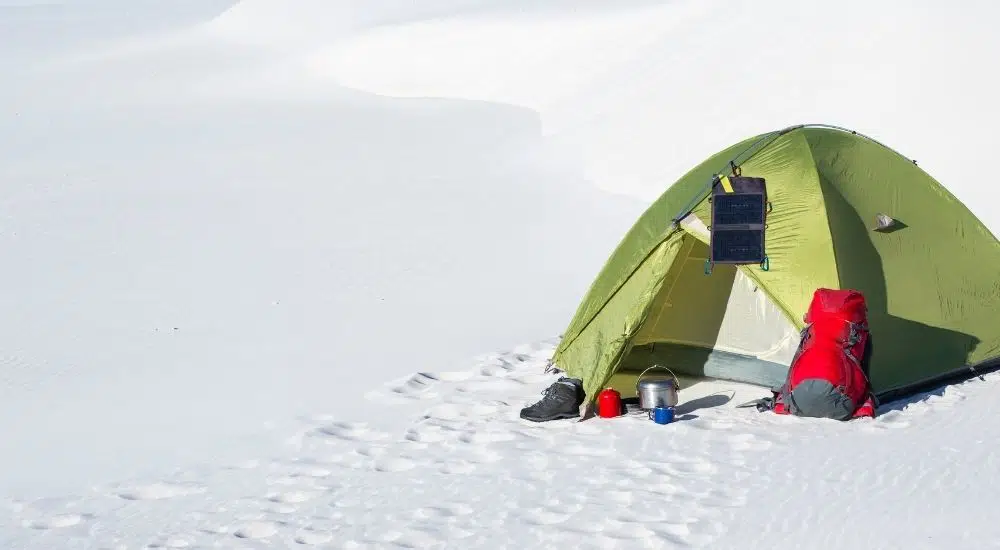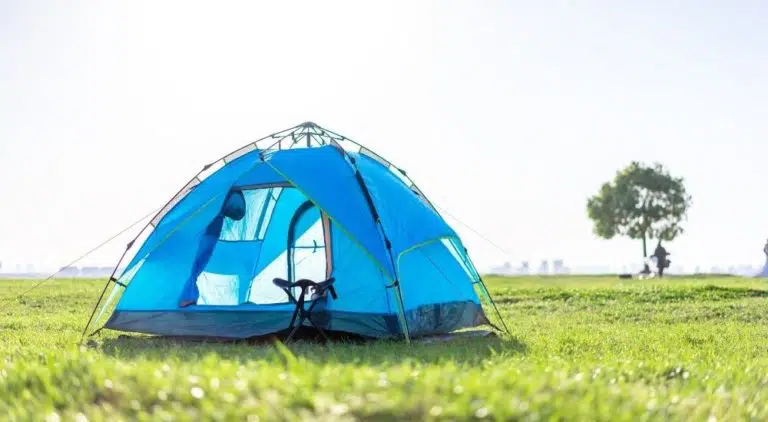How To Insulate A Tent For Winter Camping
Preparing the tent for wintertime camping can be easy. However, camping in extreme weather conditions requires you to know how to insulate a tent for winter camping. The most important task for a tent during the winter is to keep you warm followed by the ability to keep you dry.
A warm tent is a must when facing freezing wintertime weather. The following recommendations can make a tent a worthy sleeping place when camping in the winter.

How To Insulate A Tent For Winter Camping
A tent can be insulated for winter camping using such as thermal blankets, foam padding, and windbreaks. Smaller tents are easier to insulate and warmer in freezing temperatures. Canvas tents are easier to insulate compared to polyester tents.
Consider tent heaters
Small tent heaters might be needed in extreme wintertime tent camping. There are various heaters to consider for wintertime camping but all of them have limited capacity when it comes to a tent with poor insulation. Campers need to cover the tent with a thermal blanket and use a tent heater for maximum heat output.
Cover the tent with a thermal blanket
The best way to insulate a tent for winter camping is to use a thermal blanket. These types of blankets trap warm air inside the tent while keeping cold air out. Such blankets are typically waterproof as well. Often known as a heat-reflective blanket, they are added on top of the tent to trap as much heat as possible. Small and ideal for camping and hiking, thermal blankets are also effective when wrapped around the sleeping bag as they help trap air inside for comfortable warm sleeping.
Use ground mats
Ground mats are ideal for a tent in the winter. These types of mats are made with various materials and they add a layer of insulation between the ground and the camper. The mats can be extra to blankets and even carpets. It’s not uncommon to lay carpets in large tents for winter camping to add thermal insulation.
Bring extra blankets
Extra blankets are ideal for the wintertime camper. Some of the best camping blankets are made with a soft side and a waterproof side. The waterproof side of the blanket can go on the bottom of the tent where it helps insulate the bottom of the tent. The soft side-up orientation of the blanket adds warmth. Natural fleece blankets are considered very warm and ideal for wintertime camping. Fleece blankets can also be added inside the sleeping bag to help stay warm when camping in the winter.
Lay foam padding on the floor
Foam padding is ideal for insulating a tent in winter camping conditions. Foam is not a conductive material which means it doesn’t transmit heat from the ground to the body. Foam pads are known for warming up quickly. Laying foam padding all over the tent’s floor is an ideal method of insulating the tent. Oftentimes, foam padding is the only layer added on the bottom of the tent for thermal protection.
Sleep in sleeping bags
Sleeping bags have insulation of their own. Sleeping inside a tent with plenty of blankets is not as warm as sleeping in a sleeping bag that zipped up to the neck. Sleeping bags are ideal for wintertime camping as they have thick insulation.
Wear thermal clothes
Thermal clothes are part of dressing in layers for the winter. As well, it’s as helpful as thermal blankets covering the tent. While a thermal blanket slows down heat dissipation from the tent while also keeping cold air out, it has its limits in very cold weather. This is why it needs to be backed by wearing thermal clothes which are primarily made to trap body heat.
Build windbreaks
Windbreaks are an effective method of reducing cold air drafts inside the tent. Campers need to determine the wind blowing direction to see where the windbreak can be installed.
An extra rain tarp can be used as a simple windbreak solution. Snow might be an even more effective natural windbreak tent insulator. Ideally, campers know to dig a hole for the tent. Then, they need to erect small snow walls to cover at least half the height of the tent. This eliminates direct wind blowing onto the tent and it helps it stay warmer during the night.
Line the inner tent with fabrics
Lining the inner tent with various fabrics can be an effective method of insulating the tent for winter camping. Thin tent materials aren’t always up for the task when it comes to thermal protection, even if they keep the wind out of the tent. Lining the tent with blankets can trap warm air inside longer.
Use a camping cot
A camping cot can be one of the practical solutions to avoid sleeping on the cold tent floor in the winter. A good camping cot raises campers at least 5 inches above the ground which allows them.
Here’s a review of the Best Double Camping Cots for its comfort and features.
Consider canvas tents
Not all materials are suitable for thermal insulation. Summertime camping tents have a limit to the amount of heat they can retain. Canvas-made tents are ideal for wintertime camping. Large tents for winter camping are commonly made using canvas.
This is a thick material with added waterproofing. Canvas blocks out wind and it helps trap warm air inside better than synthetic materials such as polyester. While canvas is heavier and a bit more difficult to set up when used on a tent, it’s generally considered ideal for maximum thermal protection even when used without a thermal blanket.
On the other hand, canvas blankets with waterproofing can be used to cover the tent to add extra thermal protection. This can be a cheap and effective method of making a smaller tent warmer in the winter.
Consider smaller tents
Some of these recommended strategies have limited results in large tents. The larger the tent the harder it is to maintain warmth in the winter.
Smaller tents are better than larger tents for thermal protection as they can easily be covered with a thermal blanket and because there’s less air to warm up inside.
Choose tents with small opening doors
Multiple large doors on tents favor easy access. However, large access doors on tents also allow quick heat dissipation when getting out. Wintertime tents that are able to retain heat properly are those that are made with smaller doors.
Takeaway
Windbreaks are important for the ultimate thermal protection even if they aren’t technically connected to the tent. Campers need to plan windbreaks before setting up the tent. Ideal windbreaks are easy to set up. While they don’t add heat to the tent they limit the amount of cold air and wind blowing directly on the tent and blowing under the tent.
Windbreaks around the tent also maximize the thermal output of tent heaters such as portable propane heaters or other safe electric heaters.
Insulating a tent for wintertime camping typically requires going over a few steps such as adding an external cover to the tent to laying extra layers of floor-insulating materials such as foam pads and blankets.
Apart from following these steps, wintertime campers need to seal off all areas of the tent which makes it easy for warm air to escape. This includes the corners of the tent. On the other hand, at least one air circulation window of the tent should be left open to avoid condensation issues.
14 Winter Camping Hacks For Extra Comfort









